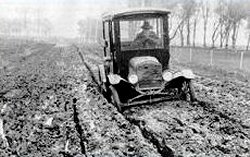Trolley lines such as this one in New Hampshire contributed greatly to growth of rural America. |
TRANSPORTATIONRoads in rural areas of the United States around 1900 varied greatly as per the terrain they traversed, but most were accessible primarily by horse or foot. Even though stagecoaches had been replaced by more viable forms of mid- to long- distance transportation, namely the railroads, this usually didn't help regional or local access via available roads in anything other than small wagons. So whether you were a miner, a farmer, or a small town merchant, it was the horse in 1900 that was not only dependable but also essential. And even at that, for many farmers a trip into town took a full day, sometimes more depending on weather, requiring the acquisition of as much in the way of staples as possible in order to minimize the need for frequent visits and lost work days. Farmers or small town citizens in areas within practical distance of a major urban area often found that there was a trolley line connection that came out their way. Entrepreneurs interested in making money with minimal real-estate investment often built beer gardens or family amusement areas at the end or planned of the mule drawn or electric trolley lines, creating the "trolley park," often irreparably reshaping the small towns they invaded. But they did encourage the light rail extensions giving increasing numbers of population access to metropolitan areas. Still, the farmers relied on the horses to get them even that far, and stables were still a big business in rural America in 1900, particularly at major junctions and trolley endpoints. The wagons themselves ranged from the surrey, a covered vehicle expressly for passengers, to the buckboard, the utility pickup truck of its time. Very few members of the rural populous owned carriages, which were enclosed vehicles.
A Ford negotiates a country road in dire need of improvement circa 1915. |
It was the advent of the automobile, in particular the
Model T Ford, the face of rural life changed quickly. There was a combination of those long rooted in farming or small towns mixing in with the few urbanites who could now commute to the city and chose to move away from it. The Model T was versatile as well, showing up as a small tractor, pickup truck, or even a bus. The latter also had an affect since shorter distances could be traversed more quickly by many people in one vehicle. Rail transportation was severely constrained by the rails themselves, but a bus could go almost anywhere that some form or road existed. But since the Model T was so versatile and cost efficient for the farm, many farmers opted to own one or more of them instead. The only impediment to extensive use of cars early on in rural areas was the scant availability of gasoline. They either had to transport it in barrels or cans from the nearest dispensing facility, or have it it delivered directly to a tank on their farm. Opportunists quickly focused in on this need and petrol stations started popping up in many moderately populated towns beginning around 1910. The horse was still essential to rural and small town life throughout this time, particularly during times of heavy rain or snow. However riding horses gradually became more of a recreational pursuit by 1920 than a transportation choice. By this time, the car was favored as a way to get to the trolley line, but trolleys and light rail were still an essential connection between urban and rural areas, particularly for far reaching commuters. The train had been relegated to long-distance travel and freight traffic. The need for better roads between cities was apparent also, which prompted the construction of the
Lincoln Highway in the mid 1910s (now largely U.S. 30), and eventually
Route 66 starting in 1926, two roads that altered the American landscape forever.








 Loading Page. Please Wait...
Loading Page. Please Wait... 





